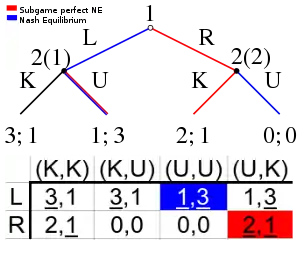Non-credible threat
A non-credible threat is a term used in game theory and economics to describe a threat in a sequential game that a rational player would actually not carry out, because it would not be in his best interest to do so.

For a simple example, suppose person A walks up, carrying a bomb, to another person B. A tells B he will set off the bomb, killing them both, unless B gives him all his money. If A is rational and non-suicidal he stands nothing to gain from setting off the bomb, so his threat cannot be considered credible. On the other hand, a person in the situation of B might give A his money, fearing that A is not rational, or might even be suicidal.
A non-credible threat is made on the hope that it will be believed, and therefore the threatening undesirable action will not need to be carried out. For a threat to be credible within an equilibrium, whenever a node is reached where a threat should be fulfilled, it will be fulfilled. Those Nash equilibria that rely on non-credible threats can be eliminated through backward induction; the remaining equilibria are called subgame perfect Nash equilibria.
External links
Schelling, Thomas C. "An essay on bargaining." The American Economic Review 46.3 (1956): 281-306. Ellsberg, Daniel. The theory and practice of blackmail. No. RAND/P-3883. RAND CORP SANTA MONICA CA, 1968.
Uri Weiss, 2015. "The Robber Wants To Be Punished," Discussion Paper Series dp685, The Federmann Center for the Study of Rationality, the Hebrew University, Jerusalem.